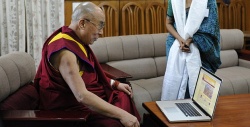The system of recognizing reincarnations in Tibet
Past and future lives were asserted in the indigenous Tibetan Bon tradition before the arrival of Buddhism. And since the spread of Buddhism in Tibet, virtually all Tibetans have believed in past and future lives. Investigating the reincarnations of many spiritual masters who upheld the Dharma, as well as the custom of praying devotedly to them, flourished everywhere in Tibet. Many authentic scriptures, indigenous Tibetan books such as the Mani Kabum and the Fivefold Kathang Teachings and others like the The Books of Kadam Disciples and the Jewel Garland: Responses to Queries, which were recounted by the glorious, incomparable Indian master Dipankara Atisha in the 11th century in Tibet, tell stories of the reincarnations of Arya Avalokiteshvara, the Bodhisattva of compassion. However, the present tradition of formally recognizing the reincarnations of masters first began in the early 13th century with the recognition of Karmapa Pagshi as the reincarnation of Karmapa Dusum Khyenpa by his disciples in accordance with his prediction. Since then, there have been seventeen Karmapa incarnations over more than nine hundred years. Similarly, since the recognition of Kunga Sangmo as the reincarnation of Khandro Choekyi Dronme in the 15th century there have been more than ten incarnations of Samding Dorje Phagmo. So, among the Tulkus recognized in Tibet there are monastics and lay tantric practitioners, male and female. This system of recognizing the reincarnations gradually spread to other Tibetan Buddhist traditions, and Bon, in Tibet. Today, there are recognized Tulkus in all the Tibetan Buddhist traditions, the Sakya, Geluk, Kagyu and Nyingma, as well as Jonang and Bodong, who serve the Dharma. It is also evident that amongst these Tulkus some are a disgrace.
The omniscient Gedun Drub, who was a direct disciple of Je Tsongkhapa, founded Tashi Lhunpo Monastery in Tsang and took care of his students. He passed away in 1474 at the age of 84. Although initially no efforts were made to identify his reincarnation, people were obliged to recognize a child named Sangye Chophel, who had been born in Tanak, Tsang (1476), because of what he had to say about his amazing and flawless recollections of his past life. Since then, a tradition began of searching for and recognizing the successive reincarnations of the Dalai Lamas by the Gaden Phodrang Labrang and later the Gaden Phodrang Government.
